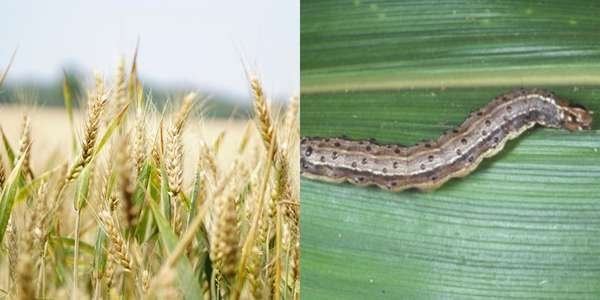Looming infestation threatens several pantry staples across Australia
By
Danielle F.
- Replies 10
As Australians, we take pride in our rich agricultural heritage and the bounty of fresh produce that graces our tables.
However, our food security is threatened by a tiny yet formidable pest out to wreak havoc on our landscapes and beloved pantries.
The fall armyworm (FAW)—a species originating in the Americas—found its way to Australian shores, with the first sighting reported in 2020.
Since then, it has become a significant problem for farmers and gardeners alike.
The pest has been particularly active in Queensland and northern NSW, where it broke havoc on crops such as oats, wheat, barley, triticale, and rye—cereals that many of us rely on for our daily sustenance.
Experts described the situation as a 'perfect storm' of conditions.
'The infestation is likely to be linked to favourable environmental conditions including rainfall that has resulted in abundant hosts, high humidity and temperatures, and crops being suitable and available for longer,' a Queensland's Department of Agriculture and Fisheries spokesperson said.
The infestation has affected regions such as the Lockyer and Fassifern Valleys, the Inner Downs, the Southern Downs, the Western Downs, and Central Queensland.
The Queensland Department of Agriculture and Fisheries urged farmers to monitor their crops closely, especially within the first ten days of emergence, as FAW larvae can cause severe damage to young plants.
For those of us who are not on the front lines of agriculture, the impact of such an infestation might seem distant.
However, the crops under attack are grains that make up our bread, cereals, and other essentials.
If left unchecked, the FAW could lead to reduced yields and higher prices for several staple foods.
So, what can be done to combat this pest?
Farmers were encouraged to conduct regular crop checks and consider delaying the planting of susceptible crops until cooler temperatures prevail, which can reduce the risk of infestation.
Pesticides and biological controls, such as introducing parasitic wasps that prey on the FAW, are also possible measures against the infestation.
'Check the soil and any remaining plants before resowing. Where crops are severely defoliated by FAW, neighbouring crops are at risk of infestation as large larvae walk out of the damaged crop looking for other food sources,' the spokesperson said.
'If FAW is detected, growers should seek support from their local agronomist.'
However, it's important to note that the FAW has never been completely eradicated from any country it has invaded, making management crucial.
For the home gardener, staying informed and vigilant is vital.
Please monitor your gardens and lawns for signs of the FAW and report any sightings to local agricultural authorities.
The fall armyworm may be here to stay, but we can protect our crops, pantries, and way of life with coordinated efforts and informed action.

What do you think of this infestation? Join the conversation and share your thoughts with us in the comments below.
However, our food security is threatened by a tiny yet formidable pest out to wreak havoc on our landscapes and beloved pantries.
The fall armyworm (FAW)—a species originating in the Americas—found its way to Australian shores, with the first sighting reported in 2020.
Since then, it has become a significant problem for farmers and gardeners alike.
The pest has been particularly active in Queensland and northern NSW, where it broke havoc on crops such as oats, wheat, barley, triticale, and rye—cereals that many of us rely on for our daily sustenance.
Experts described the situation as a 'perfect storm' of conditions.
'The infestation is likely to be linked to favourable environmental conditions including rainfall that has resulted in abundant hosts, high humidity and temperatures, and crops being suitable and available for longer,' a Queensland's Department of Agriculture and Fisheries spokesperson said.
The infestation has affected regions such as the Lockyer and Fassifern Valleys, the Inner Downs, the Southern Downs, the Western Downs, and Central Queensland.
The Queensland Department of Agriculture and Fisheries urged farmers to monitor their crops closely, especially within the first ten days of emergence, as FAW larvae can cause severe damage to young plants.
For those of us who are not on the front lines of agriculture, the impact of such an infestation might seem distant.
However, the crops under attack are grains that make up our bread, cereals, and other essentials.
If left unchecked, the FAW could lead to reduced yields and higher prices for several staple foods.
So, what can be done to combat this pest?
Farmers were encouraged to conduct regular crop checks and consider delaying the planting of susceptible crops until cooler temperatures prevail, which can reduce the risk of infestation.
Pesticides and biological controls, such as introducing parasitic wasps that prey on the FAW, are also possible measures against the infestation.
'Check the soil and any remaining plants before resowing. Where crops are severely defoliated by FAW, neighbouring crops are at risk of infestation as large larvae walk out of the damaged crop looking for other food sources,' the spokesperson said.
'If FAW is detected, growers should seek support from their local agronomist.'
However, it's important to note that the FAW has never been completely eradicated from any country it has invaded, making management crucial.
For the home gardener, staying informed and vigilant is vital.
Please monitor your gardens and lawns for signs of the FAW and report any sightings to local agricultural authorities.
The fall armyworm may be here to stay, but we can protect our crops, pantries, and way of life with coordinated efforts and informed action.
Key Takeaways
- Officials alerted Australian farmers about a 'widespread fall armyworm infestation' harming crops in Queensland and northern New South Wales.
- The infestation has made cultivating winter cereals like oats, wheat, barley, triticale, and rye difficult.
- The resurgence of fall armyworms was due to favourable environmental conditions such as prolonged rainfall, high humidity, and suitable temperatures.
- Farmers were advised to conduct regular checks on their crops, consider delaying planting susceptible crops, and employ control measures like pesticides and biological controls.
Last edited:








